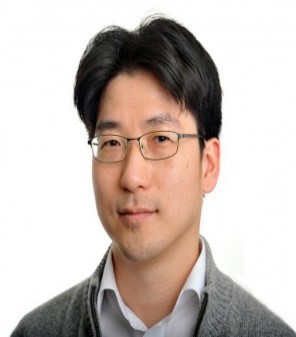주메뉴
- About IBS 연구원소개
-
Research Centers
연구단소개
- Research Outcomes
- Mathematics
- Physics
- Center for Underground Physics
- Center for Theoretical Physics of the Universe (Particle Theory and Cosmology Group)
- Center for Theoretical Physics of the Universe (Cosmology, Gravity and Astroparticle Physics Group)
- Dark Matter Axion Group
- Center for Artificial Low Dimensional Electronic Systems
- Center for Theoretical Physics of Complex Systems
- Center for Quantum Nanoscience
- Center for Exotic Nuclear Studies
- Center for Van der Waals Quantum Solids
- Center for Relativistic Laser Science
- Chemistry
- Life Sciences
- Earth Science
- Interdisciplinary
- Center for Neuroscience Imaging Research (Neuro Technology Group)
- Center for Neuroscience Imaging Research (Cognitive and Computational Neuroscience Group)
- Center for Algorithmic and Robotized Synthesis
- Center for Genome Engineering
- Center for Nanomedicine
- Center for Biomolecular and Cellular Structure
- Center for 2D Quantum Heterostructures
- Center for Quantum Conversion Research
- Institutes
- Korea Virus Research Institute
- News Center 뉴스 센터
- Career 인재초빙
- Living in Korea IBS School-UST
- IBS School 윤리경영


주메뉴
- About IBS
-
Research Centers
- Research Outcomes
- Mathematics
- Physics
- Center for Underground Physics
- Center for Theoretical Physics of the Universe (Particle Theory and Cosmology Group)
- Center for Theoretical Physics of the Universe (Cosmology, Gravity and Astroparticle Physics Group)
- Dark Matter Axion Group
- Center for Artificial Low Dimensional Electronic Systems
- Center for Theoretical Physics of Complex Systems
- Center for Quantum Nanoscience
- Center for Exotic Nuclear Studies
- Center for Van der Waals Quantum Solids
- Center for Relativistic Laser Science
- Chemistry
- Life Sciences
- Earth Science
- Interdisciplinary
- Center for Neuroscience Imaging Research (Neuro Technology Group)
- Center for Neuroscience Imaging Research (Cognitive and Computational Neuroscience Group)
- Center for Algorithmic and Robotized Synthesis
- Center for Genome Engineering
- Center for Nanomedicine
- Center for Biomolecular and Cellular Structure
- Center for 2D Quantum Heterostructures
- Center for Quantum Conversion Research
- Institutes
- Korea Virus Research Institute
- News Center
- Career
- Living in Korea
- IBS School
IBS School

Prof. LEE Doyun
Senior Research Fellow, Center for Cognition and Sociality, IBS
E-mail: leedoyun@ibs.re.kr
Lab homepage: doyunleelab.org
Research Topic
Neural mechanisms of individual recognitions
Recognizing individual conspecifics and accumulating individual-specific information through social interaction constitute a fundamental ability to survive as a member of a society. Although individual recognition has been reported in many different species including rodents, neural underpinnings of individual recognition have not been clear. My lab developed a novel individual discrimination paradigm that requires subject mice to distinguish between two familiar male siblings presented in random order and associate each with either reward or no reward.
This paradigm utilizes head-restrained mice to repetitively engage in simplified and stereotyped face-to-face interactions and allows us to quantitatively measure behavioral performance and to precisely correlate behaviors with neuronal activities. Using in vivo two-photon calcium imaging we found that activities of dorsal CA1 neurons provide information for individual conspecifics.
Research Interests
Social recognition, Hippocampus, Place cell, Episodic Memory
Education
- BS, Seoul National University (1998) – Molecular biology
- MS, Seoul National University (2000) – Molecular biology
- PhD, Seoul National University (2007) - Physiology
Major Experience
- 2007 – 2008 Postdoctoral fellow, Seoul National University
- 2008 – 2015 Postdoctoral associate, Janelia Research Campus, HHMI, USA
- 2015 – 2020 Research Fellow (Tenure-track), Center for Cognition and Sociality, IBS
- 2020 - Senior Research Fellow, Center for Cognition and Sociality, IBS
Major Publication
- Lee J, Bae C, Cho E, Lee D* and Jung MW* (2020) Transient effect of mossy fiber stimulation on spatial firing of CA3 neurons in familiar and novel environments. Hippocampus (Epub, doi:10.1002/hipo.23190) (* Co-corresponding author)
- Lee J, Yun M, Cho E, Lee JW, Lee D* and Jung MW* (2019) Transient effect of mossy fiber stimulation on spatial firing of CA3 neurons. Hippocampus, 29(7):639-651 (* Co-corresponding author)
- Lee D* and Lee AK* (2017) Whole-cell recording in the awake brain. Cold Spring Harb Protoc doi:10.1101/pdb.top087304 (* Co-corresponding author)
- Lee D* and Lee AK* (2017) In vivo patch-clamp recording in awake head-fixed rodents. Cold Spring Harb Protoc doi:10.1101/pdb.prot095802 (* Co-corresponding author)
- Lee D* and Lee AK* (2017) Efficient method for whole-cell recording in freely moving rodents using UV-cured collar-based pipette stabilization. Cold Spring Harb Protoc doi:10.1101/pdb.prot095810 (* Co-corresponding author)
- Lee D*, Shtengel G, Osborne JE, Lee AK* (2014) Anesthetized- and awake-patched whole-cell recordings in freely moving rats using UV-cured collar-based electrode stabilization. Nature Protocols, 9:2784-2795. (* Co-corresponding author)
- Lee D*, Lin B, Lee AK*. (2012) Hippocampal Place Fields Emerge upon Single-Cell Manipulation of Excitability During Behavior. Science, 337(6096):849-853 (* Co-corresponding author)
- Lee D, Lee KH, Ho WK, Lee SH. (2007) Target cell-specific involvement of presynaptic mitochondria in post-tetanic potentiation at hippocampal mossy fiber synapses. J Neurosci, 27(50):13603-13613
- Cho H, Lee D, Lee SH, Ho WK. (2005) Receptor-induced depletion of phosphatidylinositol 4,5-bisphosphate inhibits inwardly rectifying K+ channels in a receptor-specific manner. PNAS 102(12): 4643-4648
- Lee D, Han J, and Park JY (2005) Acetylcholine Induces Hyperpolarization Mediated by Activation of K(Ca) Channels in Cultured Chick Myoblasts. Korean J Physiol Pharmacol 009(01): 37-44.












